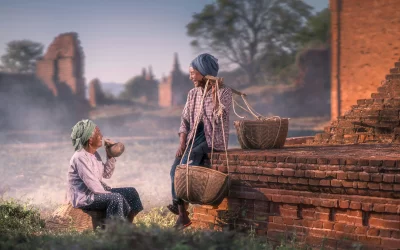While Latin America is happening all-year-around, certain events deserve extra attention.
Ranging from large iconic happenings to smaller unique celebrations, here are 7 events in Latin America that should be experienced at least once in your life.
These are worth a trip and your time, even if you’re based on the other side of the world.
La Feria De Cali, Colombia (25/12-30/12)

Salsa in a way that you haven’t seen before. Photo: icesiedu.co
I went to Cali for the first time in 2016 and it ended up becoming one of my favorite places in Colombia. It isn’t on top of every tourists’ list yet and has an authentic personality easy to fall in love with. It’s beautiful, not always picture-perfect and full of amazing places to visit.
La Feria de Cali (the Cali Fair) is the biggest happening of the year. My friends from Cali always come home for it, even if some of them don’t live there anymore. I celebrated the Feria in Cali in 2018 and loved the experience.
Introduced in 1957, the Cali Fair celebrates cultural diversity, dance, and music. The streets are colorful and happening. Some of the best dancers and musicians from Latin America (Marc Anthony, Grupo Niche, Morena Son, J Balvin – just to mention a few) are performing.
Apart from the shows and the parties, cultural events, delicious food (Cali is a great culinary destination), and more, will keep you busy.
It’s famous for crazy salsa parties and impressing dance parades until sunrise. Cali is described as the world’s salsa capital. When you’re here, it’s so easy to understand why. The salsa is on a different level.
Expect to see young kids dancing in a way that your adult friends back home only can dream of. Check out the video below if you don’t believe me.
The Cali Fair attracts up to 2 million people annually. The happy crowd from all over the world has made the event the main driver of the city’s economy during this time of the year.
Carnival of Pasto, Colombia (2/1-7/1)

The carnival of Pasto (also called Pasto’s Carnaval de Negros y Blancos or the Black and White carnival) is the largest carnival celebration in the South of Colombia. It takes place straight after the Cali Fair, so combining the two is a great plan.
I went here in 2019, and it’s a unique experience. Very different from the rest of Colombia. The culture in Pasto is more similar to Ecuador and Peru.
The Pasto carnival attracts about 10,000 number of visitors each year. It has been on UNESCO’s list of Intangible Cultural Heritage since 2009. The whole city transforms to a giant playground, with events, beer gardens, and crazy flour wars.
The most important events, the Blacks’ Day and the Whites’ Day, take place on 5th and 6th of January. Historically, the Black’s Day was when African slaves were free to enjoy themselves. The day symbolized that everyone had the same value and rights for at least one day.
People paint their faces in black and white on these days. The White’s Day presents the festival’s highlight, the Great Parade. Stretching over 15 kilometers, it’s known for its giant figures made by locals. It’s difficult to understand how it’s possible to make them. Impressing.
The Best Figure is chosen by the city. It’s possible to take part in the parade on one of the figures if you book in advance. This is definitely a unique experience.
Apart from the parade, lots of parties, concerts and events take place all over Pasto throughout the festival.
The Carnival, Brazil (February)

The carnival in Brazil doesn’t need an introduction. It’s probably featured on every list that mentions an event in South America. I went for the first time in Rio in 2018. It was so good that I celebrated it again in 2019. This time in Salvador. While I thought that would be my last time, for now, I ended up celebrating again in Rio 2020…
It deserves all the attention and more.
It’s that good.
The celebrations differ depending on what part of Brazil you’re in. While Rio is famous for the big samba show, there is so much more to it. The samba show is amazing, but the real parties happen on the streets in the form of ‘blocos’. In the area of Rio alone, there can be up to 70 official events (blocos) in one day.
During the carnival in Rio, everyone gets dressed up to everything you can imagine. It’s like a giant happy mascaraed where anything goes. It’s perfectly OK to walk around as a Dalmatian, a sexy cop, or as a shower 24/7. Yes, I met one, and the shower was working. Genius in that heat (he quickly became a popular guy)! I also saw a Borat doing errands in the bank. The ambiance is very open with people kissing and dancing everywhere.
Salvador Bahia is famous for its arranged, and crazy, events and camarotes, in addition to its street parties.
The carnival is the most fun event I’ve ever attended, so make sure to add it to your bucket list. I’m already thinking about coming back for it next year.
Mistura, Lima, Peru (September)
Heaven for foodies probably describes Mistura the best. If you still need more information to be convinced, it’s the biggest and most important food event in Latin America.
Mistura was introduced in 2008. These days, it usually takes place in the historic district of Rimac. This is where the traditional Peruvian creole music and cuisine were born. Spread out over 10 days, Mistura presents the most incredible mix of food from all over Latin America.
Mistura is constantly growing, especially since Peru has received more attention in media for its incredible gastronomy scene lately. The No.1 in Latin America’s 50 Best Restaurants of 2017 and 2018, Mitsuharu Tsumura’s Maido and Virgilio Martínez’s Central, are located in Lima. So are many other unique, delicious experiences. These days, Mistura attracts an audience of about 400.000.
Peruvian cuisine is known for being innovative and for its endless variation. With more than 260 official plates, it’s the kind of place where you will be thinking about what you’re going to eat next, even if you just eat, just because of how good everything is.
Some favorite dishes of mine to get you started (don’t blame me if you can’t stop) are Arroz de Pato, Papa a la Huancaína, Arroz con Mariscos, Rocoto Recheado, Porco Assado, and Anticuchos. Order a tasty Pisco Sour, a Chilcano or a Chicha Morada to go with it, and you’re home.
Apart from eating your way around, you can also take part in cooking classes with some of the world’s best chefs and learn about the interesting history of Peru’s gastronomy.
Día de Los Muertos (Day of the Dead), Mexico (31 October – 2 November)

The Day of the Dead is a celebration of life and death that takes place in Mexico over two days in November every year. The history of this beautiful tradition stretches back thousands of years and it has also been recognized by UNESCO. The preparations start months in advance.
The traditional belief is that the dead still are a part of the community, kept alive in memory and spirit. During the Day of the Dead, they temporarily return to earth.
An altar is built at cemeteries and in homes all over Mexico with the purpose of welcoming spirits back to life. These are filled with symbolic gifts such as food, pictures, candles, toys, and water.
The better you’ve done your research ahead of the event, the more you will be able to appreciate the deeper symbolic meaning of what’s taking place around you.
Calaveras (short, often funny, poems), skulls, costumes, parades, colorful performances, and lots of music are other characteristics of the celebrations. If you’re in Mexico, each region has their own ways of living it up. Pátzcuaro, Mexico City, and San Andrés Mixquic are some of the more well-known places for a proper celebration.
The festival is just becoming more popular. Even if the most authentic celebrations take place in Mexico, you’ll be able to celebrate big at other destinations too, such as across Latin America and in the States.
Fiesta de la Virgen de la Candelaria (The Virgin of Candelaria), Latin America (February)

Often described as one of South America’s most important festivals, the core of La Fiesta de la Virgen de la Candelaria are the musical and dance expressions.
La Virgen de la Candelaria is one of many representations of Virgin Mary, and the history of this festival goes back in time. The main purpose is to honor the purification of the Virgin Mary 40 days after the birth of Jesus.
A folklore parade, La Diablada (the Dance of the Devils, the festival’s main dance), dancing contests, the election of the Queen of Folklore, and a civic ceremony are some of the highlights.
The modern celebrations contain parades, music, beer prayers, colorful costumes, and a lot of drinking. Puno, the area around Lake Titicaca, and the village of Copacabana are destinations where you can be sure to experience bigger celebrations.
The first of the festival’s two main phases takes place on 2nd of February, with a ritual where the Virgen statue is carried around the city in a parade full of dancers. Octava, which is the second phase, takes place on the following Sunday with dance shows and competitions organized by local groups.
Expect two weeks of unforgettable events, an amazing atmosphere, and colorful celebrations with new friends.
Carnaval de Oruro, Bolivia (February)

Many places in South America host a carnival in February. The Carnival in the usually sleepy Oruro is world famous and attracts more than 400.000 visitors every year.
With a unique combination of impressing folk dances, costumes you haven’t seen before, beautiful crafts, live music, parades, and hours of non-stop partying, the Oruro Carnival is an event worth traveling for.
The carnival presents several famous icons, where El Tio, the Uncle or God of the mountains, is the most well-known. Indigenous miners believe El Tio is the owner of the mine’s minerals and in control of their safety. They’re therefore spoiling him with gifts such as beer, food, and cigarettes to keep him happy.
Using a mix of dance, music, and costumes that origin from Catholic and Indian rituals, the Carnival not only tells the story of how the Spaniards conquered the Aymara and Quechua people of Bolivia. It also celebrates evil vs good, along with Oruro’s rich cultural identity.
Make sure to book your tickets and accommodation in time, since everything will sell out for this once-in-a-lifetime fiesta.
Carnaval de Barranquilla, Colombia (February)
In 2022 I finally made it to the second biggest carnival in the world.
I’ve had the Barranquilla carnival on my bucket list for so long and now I can confirm it’s really unique.
Much more than a party (even if those take place daily for a week ?). Everyone is welcome and takes part – from viejitos to babies (babies at happening events is a normal thing in Colombia btw ?) and everything in between.
Music, culture, storytelling, costumes, dance, shows, flour wars, families and friends coming together just to enjoy life here and now.
So many talented and creative people. And an unlimited number of Queens (Colombia love Queen competitions – there is a Queen for everything). ?
Surreal to be able to go an event like this again after the panademic. I was lucky to have a local friend who is Barranquillera as the best insider guide. Our little crew made it so special. You’ll leave singing En Barranquilla me quedooo! ????
Extra tips – Other events in Latin America:
While you’re on it, here are a few other events in Latin America that you might want to check out.

-
- Tango Festival and World Cup, Buenos Aires, Argentina (August) – Two weeks of concerts, shows, classes and milongas in the world’s Tango Mecca.
- Inti Raymi, Cusco, Peru (24th of June) – The Inca Festival of the Sun attracts thousands of visitors and presents traditional rituals and shows
-
- Rock in Rio, Brasil (September) As the founder describes it: ”I realized that the tools I have to make the world a little better are the music and the festival. It’s what I know how to do well.” Previous line-ups range from Red Hot Chili Peppers and Aerosmith to Anitta, Pink, AC/DC, Queen, Iron Maiden, Coldplay, Beyoncé, Rihanna, Shakira, Avicii, Stevie Wonder and more.
-
- Lollapalooza – Argentina (March) With over 100 artists (such as Metallica, The Strokes Kygo, The Killers, and The Weeknd) over 3 days, Lollapalooza Argentina is one of three South American outposts of the iconic Lollapalooza festival series. It combines music with visual arts, fashion and food/drink in a massive outdoor setting.
- Andean Carnival – In the Provinces of Salta and Jujuy, Argentina: In the northern-most part of Argentina, Carnival is celebrated during February and March. The region is known for wine-production, beautiful vistas, and charming culture. I went village-hopping here and every little town has its own personality. The gaucho (cowboy) culture is very much alive and some locals arrived at events on a horse. Amazing.
Do you have other events in Latin America on your bucket list? Let me know in the comments.







Great posts and pictures and ideas. I’m enjoying scrolling through your page. Thank you for sharing your experiences!
Thanks Paul! More exciting posts to be published over the next weeks 🙂
I really liked your article, These events are amazing, filled with so many colors, people, and dance forms. I just love these events.
Happy that you enjoyed it!
This article is amazing!!, I really loved reading it.